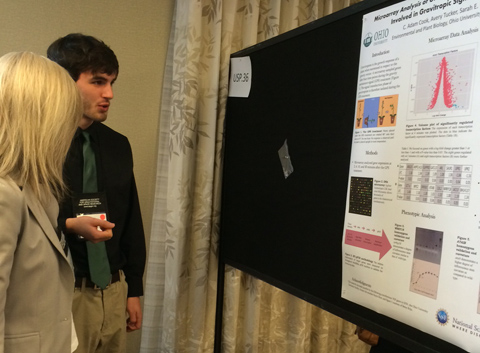Undergraduate student Adam Cook presented a poster on revealing novel genes in research on how plants respond to gravity at the annual meeting of the American Society for Gravitational and Space Research Oct. 25 in Pasadena, CA.
Co-authors on Microarray Analysis of GPS Treatment Reveals Novel Genes Involved in Gravitropic Signal Transduction were Dr. Sarah E. Wyatt, Professor of Plant Biology at Ohio University, and Avery Tucker, research assistant for Wyatt’s Team Gravitron. Read more about their experiment that will fly on the International Space Station.
Abstract: Gravity is a fundamental stimulus that affects plant growth and development. A plant’s response to gravity can be separated into three phases: perception, signal transduction, and growth response. The gravity persistent signal (GPS) treatment isolates the events of signal transduction in Arabidopsis. After cold acclimation plants are reoriented horizontally at 4°C for 1 hour then returned to vertical at room temperature. Total mRNA was collected from inflorescence stems of 8-10 cm at 2, 4, 10, and 30 minutes after reorientation in the cold. These time points were selected based on the 3 minute gravitropic presentation time of Arabidopsis. The mRNA was probed against the Arabidopsis gene expression array, 4X44 by Agilent Technologies using a dual color platform, with 4 replicates per time point. Analysis of the raw data identified 341 genes that were either significantly up or down-regulated as compared to the controls at the chosen time points: 8 genes at 2 min, 92 genes at 4 min, 180 genes at 10 min, and 61 genes at 30 min. Analyses were focused on genes showing a log fold change greater than 1.00 or less than -1.00 and a P-value of 0.05 or less at these designated time points. Within these parameters 16 genes which show the most differential expression were selected for analysis. At 2 minutes 2 genes were down-regulated and 6 were up-regulated and at 4 minutes 1 genewas down-regulated and 7 were up-regulated. qRT-PCR was performed to independently validate the expression values for each gene. Mutant lines for each gene of interest were obtained from the Arabidopsis Biological Resource Center and bred for homozygosity and analyzed for phenotype.
This research is supported by grant 1147087, National Science Foundation.




















Comments